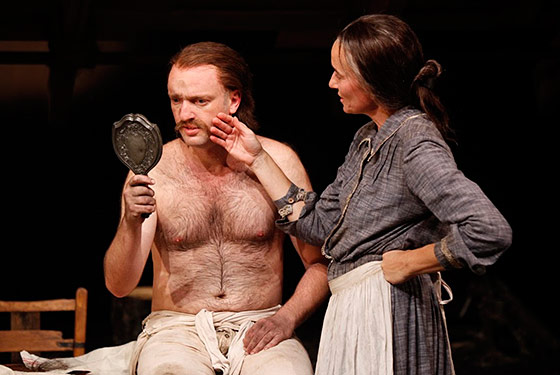
As a rule, I’m wary of “fables” written by people under the age of 500. But I admit to being pretty thoroughly bewitched by Orange, Hat & Grace at Soho Rep. This light, folkloric nightmare has the potential to be awful, from its conception on down: It’s a verse play, set in the mythic Woods and peopled with Symbols, and it prominently features a Bible-reading crone. It’s got every excuse to be yet another hazy theater “ritual,” a night of unfun indoor atavism that’s more academic smoke than naked flame.
Yet this latest one-act by Gregory Moss works its way into the creases of your soul, conjuring influences as disparate as Pygmalion and Beckett and Shepard and the grim fantasist Russell Hoban, with maybe a dash of Flowers for Algernon. And certainly a big dollop of The Tempest: Orange is essentially an inverted Caliban parable, served on a bed of cold, postapocalyptic cinders. The director, Sarah Benson (Blasted), and her extraordinary ensemble have done a great job teasing out the play’s dour humor and crystallizing its airier poetical abstractions into a small, dark jewel of a show, a vaudeville act weeviled inside the acorn shell of an ecologically tinged Baba Yaga tale.
The summary, admittedly, makes this show sound like no fun at all. Orange, an aging hermit, lives plainly and warily in a one-room cabin, trying to ignore Grace (Reyna de Courcy), the mysterious forest child who comes knocking. Played with iron and fire by Stephanie Roth Haberle, Orange is a straight-faced parody of a sacred American archetype: the suffering, steel-spined frontierswoman. She’s bivouacked in a wasteland somewhere between Wasilla and Christina’s World, and she’s (surprise, surprise) an incorrigible hypocrite. She enjoys sex with a childlike wild-man named Hat (the irreplaceable Matthew Maher, of Lear and innumerable TV character roles), whom she’s taken in as a kind of pet/surrogate child. But come daylight, she won’t let Hat speak of their night-doings. “These are called vices,” she schools him, “and we enjoy them in silence.” Beyond that prohibition, he’s definitely not to go near Grace, or there will be consequences. (No spoiler here: He does, and there are.)
Hat is simple, intuitive, and compulsive, a man-child who’s both more man and more child than the Apatovian shlubs we’ve come to associate with that overused label. He’s also intensely lovable, more so because (unlike so many boy-men) he never begs to be loved. He jokes about his hostess’s age and answers her prating Bible lessons with funny animal stories. But ultimately, as the play deepens and the woods around the homestead wither, Hat goads his lover at his own peril. Orange may be a prig and a fake, but she’s also the last outpost of what might be called civilization. She’s got something to defend: her denial, her last bulwark against darkness. That makes her dangerous. That makes the play dangerous. When you emerge from it, even the overlit city night looks a little different, a little more perilous, a little like the dark part of the woods that we’ll never be rid of, even after the woods themselves are all cut down for Moleskines and McMansions.




